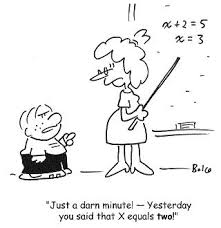MATHEMATICS STANDARDS
GRADES 6-8
MATH GRADE 8: linear equations and proportions

Mathematics
Grade 8
|
|||
Formulate and reason about expressions and
equations, including modeling an association in bivariate data with a linear
equation, and solving linear equations and systems of linear equations
|
|||
Students use linear equations and systems of
linear equations to represent, analyze, and solve a variety of problems.
Students recognize equations for proportions (y/x = m or y = mx)
as special linear equations (y = mx + b),
understanding that the constant of proportionality (m) is the slope,
and the graphs are lines through the origin. They understand that the slope (m)
of a line is a constant rate of change, so that if the input or x-coordinate
changes by an amount A, the output ory-coordinate changes
by the amount m·A. Students also use a linear equation to
describe the association between two quantities in bivariate data (such as
arm span vs. height for students in a classroom). At this grade, fitting the
model, and assessing its fit to the data are done informally. Interpreting
the model in the context of the data requires students to express a
relationship between the two quantities in question and to interpret
components of the relationship (such as slope and y-intercept) in
terms of the situation.
Students strategically choose and efficiently implement procedures to solve linear equations in one variable, understanding that when they use the properties of equality and the concept of logical equivalence, they maintain the solutions of the original equation. Students solve systems of two linear equations in two variables and relate the systems to pairs of lines in the plane; these intersect, are parallel, or are the same line. Students use linear equations, systems of linear equations, linear functions, and their understanding of slope of a line to analyze situations and solve problems. |
|||
Resources
|
|||
8.EE.5. Graph proportional
relationships, interpreting the unit rate as the slope of the graph. Compare
two different proportional relationships represented in different ways.
|
For example, compare a distance-time graph to
a distance-time equation to determine which of two moving objects has greater
speed.
|
||
8.EE.6. Use similar triangles
to explain why the slope m is the same between any two
distinct points on a
non-
vertical line in the coordinate plane; derive the equation y = mx for a
line through the origin and the equation y = mx + b for
a line intercepting the vertical axis at b.
|
|||
